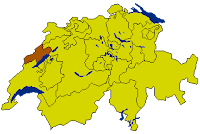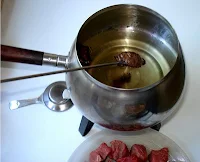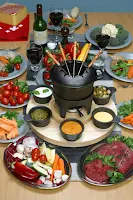Though this was not the impetus for the creation of fondue, when introduced to America, that is indeed what happened. In the Sixties and Seventies, fondue parties were all the rage.In the Eighties and Nineties, we 'Boomers' became
 'too cool' to do fondue.That was our mother's and father's generation. Beehive hairdos, polyester leisure suits, platform shoes.
'too cool' to do fondue.That was our mother's and father's generation. Beehive hairdos, polyester leisure suits, platform shoes. Happily though, in recent years, in America, fondue is making a comeback. There is even a restaurant chain dedicated to the concept. In its country of origin, Switzerland, it remains a staple of Swiss cuisine and throughout the world there are many different forms and versions.. From traditional cheese fondue, to the chocolate decadence of dessert fondue, to the actual cooking of meats in a pot of oil or broth, fondue continues to be a fun way to share a meal with friends and family. Personally I am very fond of fondue. I have been known to make it just for myself. Come along with me as we take a look at fondue and its origins, then go out get yourself a fondue set and have a party. Just don't forget to invite me. I can never get enough!
History
This warm cheese dish originated in Switzerland and more specifically, in the Canton of Neuchatel. The dish consists of at least two varieties of cheeses that are melted with wine and a bit of flour and served communally out of pot called a "caquelon." Long forks are used by each guest to spear a cube of bread then the bread is dipped into the cheese and eaten.
Fondue dates back to the 18th century when both cheese and wine were important industries in Switzerland. This simple to prepare meal utilized ingredients that were found in most average homes. French gastronome Brillat-Savarin mentioned fondue in his 19th century writings. However, fondue really hit its heyday in 1952, when Chef Konrad Egli, of New York's Chalet Swiss Restaurant, introduced a fondue method of cooking meat cubes in hot oil.
Swiss communal fondue arose many centuries ago as a result of food preservation methods. The Swiss food staples bread and raclette-like cheese made in summer and fall were meant to last throughout the winter months. The bread aged, dried out and became so tough it was sometimes chopped with an axe. The stored cheese also became very hard, but when mixed with wine (You see! Everything is better with wine!) and heated, it softened into a thick sauce. During Switzerland's long, cold winters, some families and extended roups would gather about a large pot of cheese set over the fire and dip wood-hard bits of bread, which quickly became edible.
 As Switzerland industrialized, wine and cheese producers encouraged the dish's popularity. By the 20th century, many Swiss cantons and even towns had their own local varieties and recipes based on locally available cheeses, wines and other ingredients. During the 1950s, a slowing cheese industry in Switzerland widely promoted fondue, since one person could easily eat half a pound of melted cheese in one sitting. In 1955 the first pre-mixed "instant" fondue was brought to market. Fondue became very popular in the United States during the mid-1960s after American tourists discovered it in Switzerland and through Chef Egli.
As Switzerland industrialized, wine and cheese producers encouraged the dish's popularity. By the 20th century, many Swiss cantons and even towns had their own local varieties and recipes based on locally available cheeses, wines and other ingredients. During the 1950s, a slowing cheese industry in Switzerland widely promoted fondue, since one person could easily eat half a pound of melted cheese in one sitting. In 1955 the first pre-mixed "instant" fondue was brought to market. Fondue became very popular in the United States during the mid-1960s after American tourists discovered it in Switzerland and through Chef Egli.The Swiss Tradition
 Each component of a traditional Swiss fondue plays an important role. "Traditional" Swiss style fondue is a combination of two cheeses, Gruyere and Emmenthaler. These two cheeses are combined because each cheese alone would produce a mixture that was either too sharp or too bland. The cheeses are most commonly melted in a dry white wine which helps to keep the cheese from the direct heat as it melts as well as to add flavor.
Each component of a traditional Swiss fondue plays an important role. "Traditional" Swiss style fondue is a combination of two cheeses, Gruyere and Emmenthaler. These two cheeses are combined because each cheese alone would produce a mixture that was either too sharp or too bland. The cheeses are most commonly melted in a dry white wine which helps to keep the cheese from the direct heat as it melts as well as to add flavor.  Anyone from Switzerland will tell you, "Making fondue without wine is not actually fondue, it's just melted cheese." The Kirsch (a clear cherry brandy) was added if the cheese itself was too young to produce the desired tartness. The garlic was for additional flavoring, while the flour or cornstarch assists in keeping the cheese from separating.
Anyone from Switzerland will tell you, "Making fondue without wine is not actually fondue, it's just melted cheese." The Kirsch (a clear cherry brandy) was added if the cheese itself was too young to produce the desired tartness. The garlic was for additional flavoring, while the flour or cornstarch assists in keeping the cheese from separating.The Traditional Pot (Caquelon)
The traditional fondue pot is called a "caquelon" or "câclon" and is made of a heavy earthenware. Other variations include glazed, ceramic or enameled iron. All variations are heavy, to help promote even heat distribution and heat retention. The fondue is heated on your cook-top in the caquelon over low to medium heat then transferred to the table and placed over an alcohol burner or a hot plate.
Etiquette
Given fondue is a "communal" meal, there are a few basic guidelines to follow. To eat cheese fondue, spear a piece of bread using a fondue fork and dip it into the pot. Twirl the bread cube gently in the cheese to coat it. You'll want to let the bread drip a bit before you put it in your mouth. This will allow the excess to drip back in the pot and also allow time for cooling. When you put the bread in your mouth try not to touch the fork with your lips or tongue because the fork does go back in the pot. We suggest always using a dining fork to slide the bread off the fondue fork then eating it with the dining fork. To eat meat fondue, spear a piece of meat and plunge it in the hot oil. Allow it to sit until the meat is cooked to your liking. Remove the fork and place it on your plate. Use your dining fork to slide the meat off the fondue fork. Also use your dining fork to dip the meat in the sauce as desired.
A "no double-dipping" rule also has sway: After a dipped morsel has been tasted it should never be returned to the pot or dipping sauce. In longstanding Swiss tradition, if a nugget of bread is lost in the cheese by a man, he buys a bottle of wine and if such a thing happens to befall a woman, she kisses the man on her left. Lately, rather more humorous twists on this have shown up in Switzerland such as young diners diving into the snow whilst clad only in underwear. Children will sometimes fight over the cracker-like la religieuse left at the bottom of the emptied caquelon.
 The Bread
The BreadA baguette works very well although any crusty French or Italian style breads will do. When you slice the bread, make sure that each piece includes a bit of the crust. This crust helps keep the bread on the fork after it is placed in the cheese.
Recipes
Three-Cheese Fondue with Champagne
Yield: Makes 2 servings
Ingredients
4 teaspoons cornstarch
2 cups coarsely grated Gruyère cheese (about 7 ounces)
1 tablespoon fresh lemon juice
1 1/4 cups dry (brut) Champagne
1 large shallot, chopped 1/3 cups grated Emmenthal cheese (about 5 ounces)
1/2 cup diced rind-less Brie or Camembert cheese (about 3 ounces)
Generous pinch of ground nutmeg
Pinch of ground white pepper
1 French-bread baguette, crust left on, bread cut into 1-inch cubes
Method
Stir cornstarch and lemon juice in small bowl until cornstarch dissolves; set aside. Combine Champagne and shallot in fondue pot or heavy medium saucepan; simmer over medium heat 2 minutes. Remove pot from heat. Add all cheeses and stir to combine. Stir in cornstarch mixture. Return fondue pot to medium heat and stir until cheeses are melted and smooth and fondue thickens and boils, about 12 minutes. Season fondue with nutmeg and white pepper. Place over candle or canned heat burner to keep warm. Serve with bread cubes.
Dessert Fondue
Dessert fondues became very popular in the 1970's. Chocolate fondue was a favorite used for dipping ripe fruits such as bananas, strawberries and tangerines. Some recipes suggest dipping some cubes of angel food cake as well. Other dessert fondues include caramel, coconut and marshmallow.
White Chocolate Fondue
Serves 6
Ingredients
1 cup heavy cream
1/2 stick unsalted butter
2 packages (12 ounces each) premier white morsels,
Dippers
Fresh fruits - bananas, strawberries, grapes, tangerines, pears, apples, raspberries. Fresh fruit should be ripe but still firm enough to not dissolve while dipping.
Dried fruit - apricots, dates, figs
Cakes or cookies - Bite sized pieces of angel food cake, pound cake, lady fingers or crisp biscotti
Method
In a large saucepan over medium heat, combine cream and butter. Bring mixture to a simmer, stirring constantly. Remove pan from heat. Add white morsels. Stir until melted and smooth. Cool slightly. Transfer to a fondue pot, chafing dish, or ceramic bowl. Serve with apples, bananas, strawberries, cookies, pretzels, and pound cake.
Other Fondue Styles
Broth or Bouillon
 Shabu Shabu is the Japanese version of fondue using vegetable broth or boullion. This makes a lighter, less caloric meal than the cheese or hot oil versions. Potatoes as well as other vegetables or small bits of seafood are cooked in the simmering pot of broth.
Shabu Shabu is the Japanese version of fondue using vegetable broth or boullion. This makes a lighter, less caloric meal than the cheese or hot oil versions. Potatoes as well as other vegetables or small bits of seafood are cooked in the simmering pot of broth.
Fonduta
Fonduta is an Italian dish similar to Fondue made with Fontina cheese and egg yolks.
Fondue Bourguignonne
 Also referred to as Beef Fondue. A mixture of half butter and half cooking oil is combined and heated in a cast iron or enamel fondue pot. Small pieces of lean meat and vegetables are speared and cooked in the hot oil. It is particularly important to use a stable fondue pot for this type of fondue.
Also referred to as Beef Fondue. A mixture of half butter and half cooking oil is combined and heated in a cast iron or enamel fondue pot. Small pieces of lean meat and vegetables are speared and cooked in the hot oil. It is particularly important to use a stable fondue pot for this type of fondue. Bagna Cauda
Bagna CaudaThis is a wonderful dish from the Piedmonte region of Italy. The name comes from bagno caldo which means "hot bath". It is made by combining butter, olive oil, garlic and anchovies. The mixture is heated and guests use wooden skewers or fondue forks to spear a variety of fresh vegetables, meats and seafood which are dipped and warmed.
This is a Dutch dish (cheese dip) similar to the Italian style fonduta.
I've only one more suggestion: If you decide to have your own Fondue party....make sure I get an invite!!! Thanks for taking the dip into Fondue with me...
Bon Appetit,




















